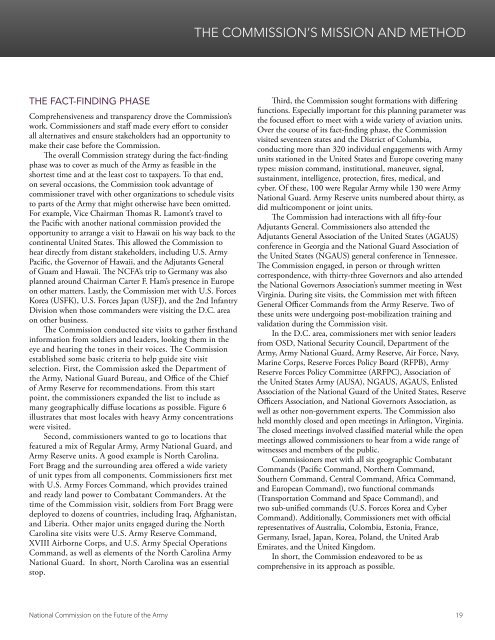THE FUTURE OF THE ARMY
1PlAz6L
1PlAz6L
Create successful ePaper yourself
Turn your PDF publications into a flip-book with our unique Google optimized e-Paper software.
<strong>THE</strong> COMMISSION’S MISSION AND METHOD<br />
<strong>THE</strong> FACT-FINDING PHASE<br />
Comprehensiveness and transparency drove the Commission’s<br />
work. Commissioners and staff made every effort to consider<br />
all alternatives and ensure stakeholders had an opportunity to<br />
make their case before the Commission.<br />
The overall Commission strategy during the fact-finding<br />
phase was to cover as much of the Army as feasible in the<br />
shortest time and at the least cost to taxpayers. To that end,<br />
on several occasions, the Commission took advantage of<br />
commissioner travel with other organizations to schedule visits<br />
to parts of the Army that might otherwise have been omitted.<br />
For example, Vice Chairman Thomas R. Lamont’s travel to<br />
the Pacific with another national commission provided the<br />
opportunity to arrange a visit to Hawaii on his way back to the<br />
continental United States. This allowed the Commission to<br />
hear directly from distant stakeholders, including U.S. Army<br />
Pacific, the Governor of Hawaii, and the Adjutants General<br />
of Guam and Hawaii. The NCFA’s trip to Germany was also<br />
planned around Chairman Carter F. Ham’s presence in Europe<br />
on other matters. Lastly, the Commission met with U.S. Forces<br />
Korea (USFK), U.S. Forces Japan (USFJ), and the 2nd Infantry<br />
Division when those commanders were visiting the D.C. area<br />
on other business.<br />
The Commission conducted site visits to gather firsthand<br />
information from soldiers and leaders, looking them in the<br />
eye and hearing the tones in their voices. The Commission<br />
established some basic criteria to help guide site visit<br />
selection. First, the Commission asked the Department of<br />
the Army, National Guard Bureau, and Office of the Chief<br />
of Army Reserve for recommendations. From this start<br />
point, the commissioners expanded the list to include as<br />
many geographically diffuse locations as possible. Figure 6<br />
illustrates that most locales with heavy Army concentrations<br />
were visited.<br />
Second, commissioners wanted to go to locations that<br />
featured a mix of Regular Army, Army National Guard, and<br />
Army Reserve units. A good example is North Carolina.<br />
Fort Bragg and the surrounding area offered a wide variety<br />
of unit types from all components. Commissioners first met<br />
with U.S. Army Forces Command, which provides trained<br />
and ready land power to Combatant Commanders. At the<br />
time of the Commission visit, soldiers from Fort Bragg were<br />
deployed to dozens of countries, including Iraq, Afghanistan,<br />
and Liberia. Other major units engaged during the North<br />
Carolina site visits were U.S. Army Reserve Command,<br />
XVIII Airborne Corps, and U.S. Army Special Operations<br />
Command, as well as elements of the North Carolina Army<br />
National Guard. In short, North Carolina was an essential<br />
stop.<br />
Third, the Commission sought formations with differing<br />
functions. Especially important for this planning parameter was<br />
the focused effort to meet with a wide variety of aviation units.<br />
Over the course of its fact-finding phase, the Commission<br />
visited seventeen states and the District of Columbia,<br />
conducting more than 320 individual engagements with Army<br />
units stationed in the United States and Europe covering many<br />
types: mission command, institutional, maneuver, signal,<br />
sustainment, intelligence, protection, fires, medical, and<br />
cyber. Of these, 100 were Regular Army while 130 were Army<br />
National Guard. Army Reserve units numbered about thirty, as<br />
did multicomponent or joint units.<br />
The Commission had interactions with all fifty-four<br />
Adjutants General. Commissioners also attended the<br />
Adjutants General Association of the United States (AGAUS)<br />
conference in Georgia and the National Guard Association of<br />
the United States (NGAUS) general conference in Tennessee.<br />
The Commission engaged, in person or through written<br />
correspondence, with thirty-three Governors and also attended<br />
the National Governors Association’s summer meeting in West<br />
Virginia. During site visits, the Commission met with fifteen<br />
General Officer Commands from the Army Reserve. Two of<br />
these units were undergoing post-mobilization training and<br />
validation during the Commission visit.<br />
In the D.C. area, commissioners met with senior leaders<br />
from OSD, National Security Council, Department of the<br />
Army, Army National Guard, Army Reserve, Air Force, Navy,<br />
Marine Corps, Reserve Forces Policy Board (RFPB), Army<br />
Reserve Forces Policy Committee (ARFPC), Association of<br />
the United States Army (AUSA), NGAUS, AGAUS, Enlisted<br />
Association of the National Guard of the United States, Reserve<br />
Officers Association, and National Governors Association, as<br />
well as other non-government experts. The Commission also<br />
held monthly closed and open meetings in Arlington, Virginia.<br />
The closed meetings involved classified material while the open<br />
meetings allowed commissioners to hear from a wide range of<br />
witnesses and members of the public.<br />
Commissioners met with all six geographic Combatant<br />
Commands (Pacific Command, Northern Command,<br />
Southern Command, Central Command, Africa Command,<br />
and European Command), two functional commands<br />
(Transportation Command and Space Command), and<br />
two sub-unified commands (U.S. Forces Korea and Cyber<br />
Command). Additionally, Commissioners met with official<br />
representatives of Australia, Colombia, Estonia, France,<br />
Germany, Israel, Japan, Korea, Poland, the United Arab<br />
Emirates, and the United Kingdom.<br />
In short, the Commission endeavored to be as<br />
comprehensive in its approach as possible.<br />
National Commission on the Future of the Army 19


